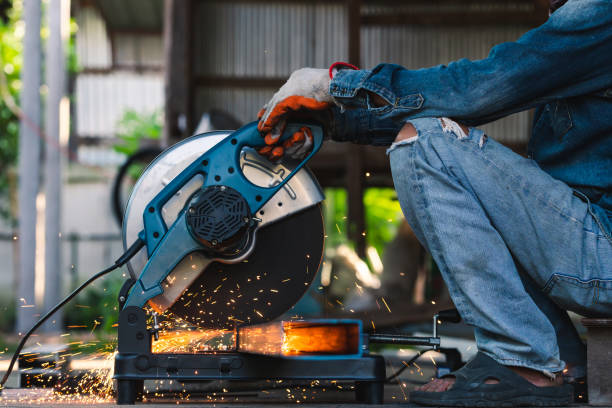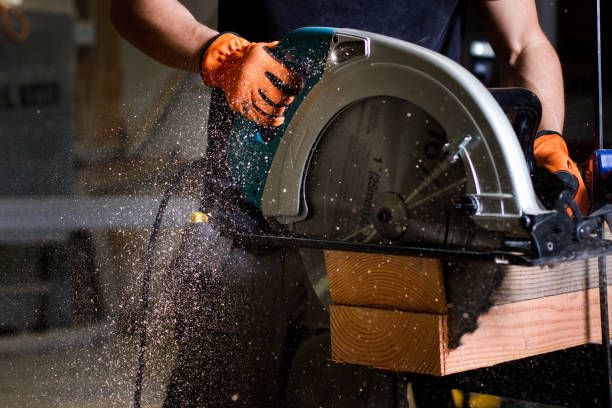Chop saws are indispensable tools in metalworking, woodworking, and construction industries. They provide precise, straight cuts on various materials, making them a go-to tool for professionals and hobbyists alike. However, achieving optimal cutting efficiency with chop saws requires understanding the right techniques, choosing appropriate accessories like cut off wheels and saw blades, and maintaining the equipment properly. This article delves into effective strategies to enhance cutting efficiency using chop saws.
Understanding Chop Saws
Chop saws, also known as cut-off saws or abrasive saws, are designed to make straight cuts on hard materials. These tools typically use large cut off wheels or carbide-tipped blades to slice through metal, masonry, and wood. The efficiency of a chop saw largely depends on the type of blade or wheel used, the material being cut, and the operator’s technique.
Choosing the Right Cut Off Wheel
Cut off wheels are critical for chop saw performance. The right wheel can significantly impact cutting speed, accuracy, and overall efficiency. Here are some tips for selecting the best cut off wheel for your needs:
- Material Compatibility:Ensure the cut off wheel is suitable for the material you’re cutting. There are specific wheels designed for metal, masonry, and other materials. Using a wheel not designed for your material can reduce efficiency and damage the wheel.
- Wheel Size: Large cut off wheels are preferred for heavy-duty cutting tasks as they provide more surface area for cutting, which enhances speed and efficiency. However, ensure your chop saw can accommodate the wheel size.
- Abrasive Composition:Different abrasives are used in cut off wheels, such as aluminum oxide for metal cutting and silicon carbide for masonry. Choose the abrasive that matches your cutting requirements.
- Bond Strength: The bond that holds the abrasive grains together affects the wheel’s performance. A strong bond is suitable for tough materials, ensuring the wheel remains effective for longer periods.
Selecting the Right Saw Blade
Saw blades are another critical component influencing chop saw efficiency. Carbide-tipped blades are particularly popular due to their durability and cutting precision. Here’s how to choose the right saw blade:
- Blade Material: Carbide-tipped blades are excellent for cutting through tough materials like metals and hard woods. Their durability and sharpness provide cleaner and faster cuts compared to standard steel blades.
- Tooth Count: Blades with more teeth provide smoother cuts but may cut slower, while blades with fewer teeth cut faster but can leave rough edges. Choose the tooth count based on the finish quality you need.
- Blade Diameter:Ensure the blade diameter matches your chop saw’s specifications. Larger blades can handle bigger materials, but they must be compatible with your saw.
- Kerf Width:The kerf width is the thickness of the blade’s cut. Thinner kerfs remove less material, resulting in faster cuts and less waste, but they may be less stable. Balance kerf width with the material thickness and cutting stability.
Optimizing Cutting Techniques
Even with the best cut off wheel or saw blade, cutting efficiency depends significantly on the operator’s technique. Here are some tips to improve your cutting technique:
- Proper Positioning: Secure the material firmly to prevent movement during cutting. Use clamps or a vice to hold the material in place.
- Steady Feed Rate: Maintain a consistent and steady feed rate. Pushing too fast can cause the blade to bind and overheat, while going too slow can lead to inefficient cuts and unnecessary wear on the blade.
- Cooling and Lubrication:For metal cutting, using a coolant or lubricant can help reduce heat and friction, prolonging the blade’s life and improving cut quality.
- Correct Angle:Align the material and saw blade correctly to ensure a straight cut. Misalignment can cause uneven cuts and put stress on the blade, reducing its efficiency.
- Cutting Sequence:For large or thick materials, make a series of shallow cuts rather than one deep cut. This approach reduces stress on the blade and helps maintain cutting efficiency.
Maintaining Your Chop Saw
Regular maintenance of your chop saw is crucial for ensuring consistent cutting efficiency. Here are some maintenance tips:
- Clean the Saw Regularly:Dust and debris can accumulate on the saw and its components, leading to reduced efficiency. Clean the saw regularly, especially after heavy use.
- Inspect Blades and Wheels: Regularly check the condition of your cut off wheels and saw blades. Look for signs of wear, such as dullness, chipping, or cracking, and replace them as needed.
- Check Alignments: Ensure the blade or wheel is properly aligned with the saw. Misalignment can cause inefficient cuts and damage the material and tool.
- Lubricate Moving Parts:Keep the moving parts of the saw well-lubricated to reduce friction and wear. This practice ensures smooth operation and prolongs the saw’s lifespan.
- Monitor Electrical Components: Regularly inspect the power cord and switches for wear and damage. Faulty electrical components can affect saw performance and safety.
Safety Considerations
Improving cutting efficiency also involves adhering to safety practices. Here are some safety tips to keep in mind:
- Wear Protective Gear:Always wear safety goggles, gloves, and hearing protection when operating a chop saw.
- Secure the Work Area: Ensure the work area is clean and free of obstructions. Securely anchor the chop saw to prevent movement during operation.
- Follow Manufacturer Guidelines: Adhere to the manufacturer’s instructions for operating and maintaining the chop saw. This adherence ensures safe and efficient use of the tool.
- Avoid Overloading the Saw:Do not force the saw to cut materials it is not designed for. Overloading can damage the saw and create safety hazards.
Conclusion
Improving cutting efficiency with chop saws involves selecting the right cut off wheels and saw blades, mastering cutting techniques, maintaining the saw, and following safety protocols. By choosing the appropriate large cut off wheel or carbide-tipped blade for your material, you can achieve cleaner, faster cuts with less wear on your equipment. Proper technique and regular maintenance further ensure that your chop saw operates at peak efficiency, providing reliable and precise cuts for your projects. Adhering to these practices not only enhances productivity but also extends the life of your chop saw, making it a valuable investment for any workshop.


